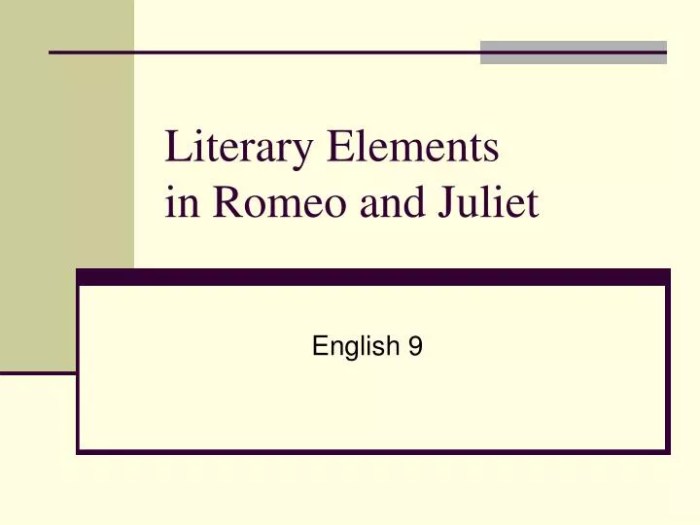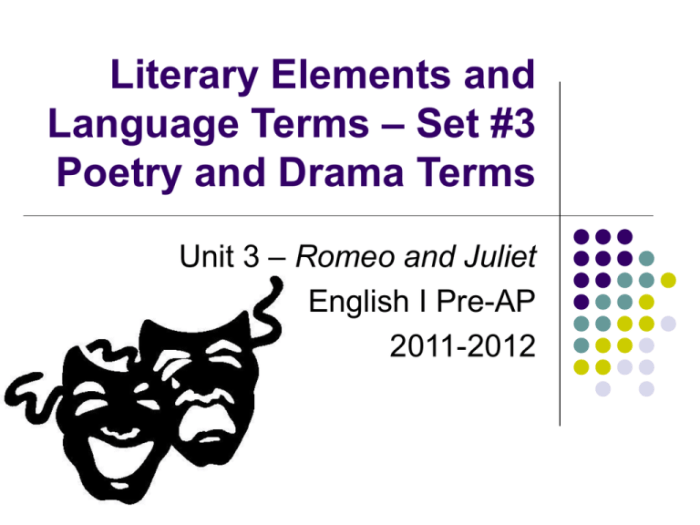An in-depth exploration of the literary elements in Romeo and Juliet unveils the profound themes, intricate characters, and evocative language that have captivated audiences for centuries. This comprehensive analysis delves into the play’s structure, setting, language, and cultural context, shedding light on its enduring relevance and universal appeal.
Through the examination of character motivations, plot development, and the use of literary devices, this study unravels the complexities of love, fate, and the human condition, providing a deeper understanding of one of Shakespeare’s most beloved tragedies.
Character Analysis

Romeo and Juliet are the central characters of the play, and their relationship drives the plot. Romeo is a young, passionate, and impulsive man, while Juliet is a beautiful, intelligent, and headstrong woman. They are both deeply in love, but their love is forbidden by their families, who are sworn enemies.
The supporting characters also play important roles in the plot. Mercutio is Romeo’s best friend, and he is a witty and Mercurial character. Tybalt is Juliet’s cousin, and he is a hot-headed and violent man. Friar Laurence is a wise and compassionate priest who tries to help Romeo and Juliet, but his plans ultimately lead to their deaths.
The use of foil characters helps to highlight the traits of the main characters. Mercutio is a foil to Romeo, as he is more rational and less impulsive. Tybalt is a foil to Romeo, as he is more violent and aggressive.
Friar Laurence is a foil to Romeo and Juliet, as he is older and wiser than they are.
Plot Structure
Romeo and Juliet is a five-act play, and each act builds tension and suspense. The first act introduces the characters and the conflict between their families. The second act sees Romeo and Juliet fall in love, and the third act sees them marry in secret.
The fourth act sees Romeo banished from Verona, and Juliet agrees to marry Paris. The fifth act sees Romeo and Juliet die.
The major plot points include Romeo and Juliet’s first meeting, their marriage, Romeo’s banishment, and their deaths. The turning points include Mercutio’s death, Tybalt’s death, and Juliet’s decision to take the potion.
Shakespeare uses foreshadowing and irony to create dramatic effect. For example, the prologue foreshadows the deaths of Romeo and Juliet, and the audience knows that the two lovers will not have a happy ending. The use of irony is also evident in the scene where Romeo kills Tybalt, as he does so in order to avenge Mercutio’s death, but his actions ultimately lead to his own banishment.
Setting and Atmosphere

The play is set in Verona, Italy, during the Renaissance period. The setting influences the characters and events of the play. The city is a hotbed of violence and hatred, and the characters are constantly in danger of being killed or injured.
Shakespeare uses imagery and symbolism to create a specific atmosphere and mood. The play is full of images of light and dark, and these images are used to represent the different aspects of the characters and their relationships. The use of symbolism is also evident in the play’s use of flowers, which are often used to represent love and beauty.
Time plays an important role in the play. The action takes place over a period of just a few days, and the characters are constantly aware of the passage of time. The use of time helps to create a sense of urgency and suspense.
Themes
The play explores a number of themes, including love, fate, and family. Love is the central theme of the play, and it is shown to be a powerful and destructive force. Fate is also a major theme, and the characters are often seen as being helpless victims of fate.
Family is another important theme, and the play explores the conflicts that can arise between family loyalty and personal happiness.
Shakespeare uses symbolism and imagery to reinforce the play’s themes. For example, the use of light and dark imagery represents the different aspects of love, and the use of flowers represents love and beauty.
Language and Style

Shakespeare uses a variety of language and style in Romeo and Juliet. The play is written in iambic pentameter, which is a type of poetry that uses a regular rhythm of unstressed and stressed syllables. Shakespeare also uses a variety of metaphors, similes, and puns.
The use of poetry and prose in the play helps to create a specific tone and mood. The poetry is used to create a sense of beauty and romance, while the prose is used to create a sense of realism and urgency.
Shakespeare also uses a variety of rhetorical devices, such as antithesis and hyperbole, to create dramatic effect. For example, the use of antithesis in the line “For never was a story of more woe / Than this of Juliet and her Romeo” helps to create a sense of contrast and tension.
Cultural and Historical Context
Romeo and Juliet was written and performed during the Elizabethan period, and the play reflects the values and beliefs of that time. The play’s focus on love and marriage reflects the importance of these institutions in Elizabethan society. The play’s use of violence and bloodshed also reflects the violent nature of Elizabethan society.
Romeo and Juliet is still relevant to contemporary audiences because it explores universal themes such as love, fate, and family. The play’s enduring appeal is due to its powerful characters, its timeless themes, and its beautiful language.
FAQ Section: Literary Elements In Romeo And Juliet
What are the main themes explored in Romeo and Juliet?
The play delves into the complexities of love, fate, and the consequences of impulsive actions.
How does Shakespeare’s use of language contribute to the play’s impact?
His masterful use of metaphors, similes, and puns adds depth and emotional resonance to the characters and their experiences.
What is the significance of the play’s setting in Verona?
The setting reflects the social and political tensions of Elizabethan England, providing a backdrop for the tragic events that unfold.